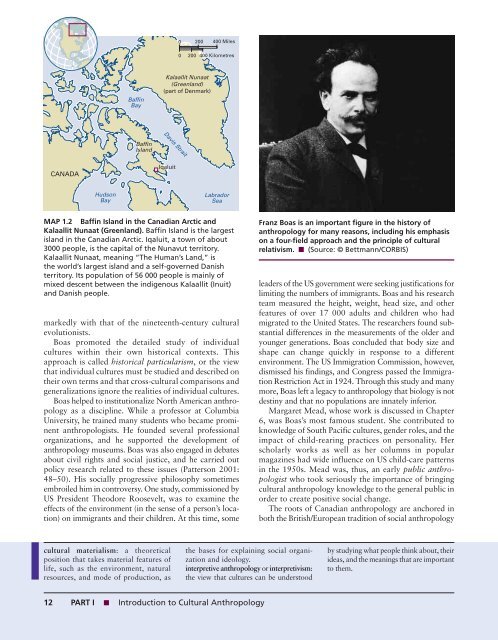PART Introduction to Cultural Anthropology - Pearson Canada
PART Introduction to Cultural Anthropology - Pearson Canada
PART Introduction to Cultural Anthropology - Pearson Canada
You also want an ePaper? Increase the reach of your titles
YUMPU automatically turns print PDFs into web optimized ePapers that Google loves.
0 200 400 Miles<br />
0 200 400 Kilometres<br />
Baffin<br />
Bay<br />
Kalaallit Nunaat<br />
(Greenland)<br />
(part of Denmark)<br />
Davis Strait<br />
Baffin<br />
Island<br />
CANADA<br />
Iqaluit<br />
Hudson<br />
Bay<br />
Labrador<br />
Sea<br />
MAP 1.2 Baffin Island in the Canadian Arctic and<br />
Kalaallit Nunaat (Greenland). Baffin Island is the largest<br />
island in the Canadian Arctic. Iqaluit, a <strong>to</strong>wn of about<br />
3000 people, is the capital of the Nunavut terri<strong>to</strong>ry.<br />
Kalaallit Nunaat, meaning “The Human’s Land,” is<br />
the world’s largest island and a self-governed Danish<br />
terri<strong>to</strong>ry. Its population of 56 000 people is mainly of<br />
mixed descent between the indigenous Kalaallit (Inuit)<br />
and Danish people.<br />
markedly with that of the nineteenth-century cultural<br />
evolutionists.<br />
Boas promoted the detailed study of individual<br />
cultures within their own his<strong>to</strong>rical contexts. This<br />
approach is called his<strong>to</strong>rical particularism, or the view<br />
that individual cultures must be studied and described on<br />
their own terms and that cross-cultural comparisons and<br />
generalizations ignore the realities of individual cultures.<br />
Boas helped <strong>to</strong> institutionalize North American anthropology<br />
as a discipline. While a professor at Columbia<br />
University, he trained many students who became prominent<br />
anthropologists. He founded several professional<br />
organizations, and he supported the development of<br />
anthropology museums. Boas was also engaged in debates<br />
about civil rights and social justice, and he carried out<br />
policy research related <strong>to</strong> these issues (Patterson 2001:<br />
48–50). His socially progressive philosophy sometimes<br />
embroiled him in controversy. One study, commissioned by<br />
US President Theodore Roosevelt, was <strong>to</strong> examine the<br />
effects of the environment (in the sense of a person’s location)<br />
on immigrants and their children. At this time, some<br />
Franz Boas is an important figure in the his<strong>to</strong>ry of<br />
anthropology for many reasons, including his emphasis<br />
on a four-field approach and the principle of cultural<br />
relativism. ■ (Source: © Bettmann/CORBIS)<br />
leaders of the US government were seeking justifications for<br />
limiting the numbers of immigrants. Boas and his research<br />
team measured the height, weight, head size, and other<br />
features of over 17 000 adults and children who had<br />
migrated <strong>to</strong> the United States. The researchers found substantial<br />
differences in the measurements of the older and<br />
younger generations. Boas concluded that body size and<br />
shape can change quickly in response <strong>to</strong> a different<br />
environment. The US Immigration Commission, however,<br />
dismissed his findings, and Congress passed the Immigration<br />
Restriction Act in 1924. Through this study and many<br />
more, Boas left a legacy <strong>to</strong> anthropology that biology is not<br />
destiny and that no populations are innately inferior.<br />
Margaret Mead, whose work is discussed in Chapter<br />
6, was Boas’s most famous student. She contributed <strong>to</strong><br />
knowledge of South Pacific cultures, gender roles, and the<br />
impact of child-rearing practices on personality. Her<br />
scholarly works as well as her columns in popular<br />
magazines had wide influence on US child-care patterns<br />
in the 1950s. Mead was, thus, an early public anthropologist<br />
who <strong>to</strong>ok seriously the importance of bringing<br />
cultural anthropology knowledge <strong>to</strong> the general public in<br />
order <strong>to</strong> create positive social change.<br />
The roots of Canadian anthropology are anchored in<br />
both the British/European tradition of social anthropology<br />
cultural materialism: a theoretical<br />
position that takes material features of<br />
life, such as the environment, natural<br />
resources, and mode of production, as<br />
the bases for explaining social organization<br />
and ideology.<br />
interpretive anthropology or interpretivism:<br />
the view that cultures can be unders<strong>to</strong>od<br />
by studying what people think about, their<br />
ideas, and the meanings that are important<br />
<strong>to</strong> them.<br />
12 <strong>PART</strong> I ■ <strong>Introduction</strong> <strong>to</strong> <strong>Cultural</strong> <strong>Anthropology</strong>
















